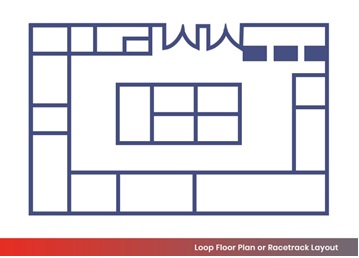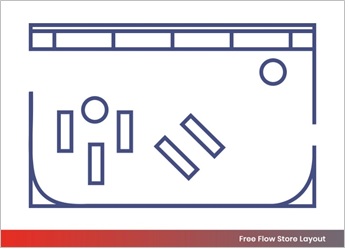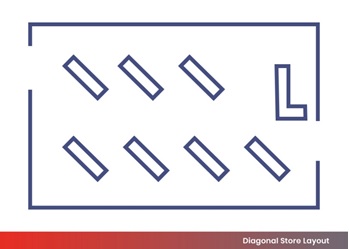Touching it, holding it, trying it on – there are some unique store experiences that digital shopping cannot replace. Retail stores are still highly relevant, and the store’s design layout plays an important role in converting walk-ins to sales. In the digital age, the end point of sales has shifted, sometimes almost imperceptibly, to the process of ordering items online. A growing shopping trend is for consumers to search and view items online, visit stores to see and handle the actual product in its actual size and then order the item online, or visit what are known as brick-and-mortar houses first and go home to order the goods online. There are valid reasons why this process is becoming increasingly popular, and with the help of new technology and high-quality 3D architectural modelling and architectural rendering services, the decision-making process for consumers becomes easier.
Retail store layouts are well researched and well planned to maximise sales for different products. There are a few typical retail store layouts that are repeatedly used, depending on the shape and size of the store and the products sold there. In general, grocery stores use grid layouts for easy navigation and the predictability factor. When businesses want to highlight different products, such as in boutiques, more creative layouts are used.
Retail Floor Plans
Grid

Also called a straight layout, grid floor plans feature:
Used mainly in grocery and convenience stores, the grid plan layout creates a feeling of familiarity.
Loop

Also called a racetrack layout, the loop floor plan guides shoppers around the floor. Its features consist of:
This plan works well for apparel, accessories, toys, homeware, kitchenware, personal care products and specialty products.
Free Flow

This store layout caters for maximum creativity and can be easily modified. Its main advantages are:
This plan is ideal for boutiques, upscale stores, specialty stores with small inventories, highlighting special products, such as apparel, accessories, personal care, specialty brands, rather than store goods of large quantity
Diagonal

A diagonal store layout encourages shoppers to test or sample merchandise. Its features include:
This plan is preferred in electronic or technology stores, beauty and cosmetic retailers and specialty food stores.
Along with determining the most suitable floor plan for the merchandise being sold, there are a few other factors that retailers might consider.
Tips for Retail Floor Plans
More products on the sales floor has led to increased sales. However, having an excessive amount of product on the sales floor could lead to negative brand perception, especially for boutique or high-end retailers. Discount retailers can pack the shop with merchandise as part of a successful strategy. High-end stores put up only a few selected items for display to emphasise exclusivity.
Customer personal space is important, but shelves can still be packed with merchandise.
Several factors encourage online shopping today. Besides being convenient, frequently cheaper and enabling the luxury of staying at home without venturing into uncomfortable weather or traffic conditions, consumers prefer to browse at traditional outlets, or brick-and-mortar shops, to get a more realistic look and feel of the product and then make their actual purchases online. Interestingly, some digital stores are launching traditional stores in addition to their digital presence, especially apparel stores, while traditional retailers are moving to the digital arena to stay relevant. There are a host of reasons why this works well for both sellers and buyers.
Though they started online, digital brands are expanding their reach by launching traditional stores and are predicted to continue doing so. Buyers benefit from physically handling the merchandise they see online and can make purchases at their convenience from home.
Augmented reality technology is helping to bridge the digital and physical divides. Large brands, especially in furniture, have begun to include AR features to help shoppers picture furniture in their homes. An app called Shopify helps make AR technology available to smaller brands through Shopify AR. This enables shoppers to browse for furniture in a real store and then go home and view (on their phone cameras) how merchandise, such as tables, beds, etc., will look in their homes, whether the furniture matches their home décor and then they can order online rather than revisit the store.
Both e-commerce and traditional stores are increasingly providing options to customise purchases, so that consumers can buy products personalised to their needs, from personalised embroidery on jeans and jackets and even customised shoes. While visiting a retail store, shoppers can better understand how these products look and feel.
A retail trend that allows shoppers to take a photo and then search multiple sites, locate and purchase an item with just a click is powered by AI (artificial intelligence). The Lens feature of Pinterest uses this technology and the Pinterest App camera to look for visually similar pins. Retailers use high quality and current visual assets to represent their wares. Consumers can see the actual merchandise, click a picture and later locate the item online for the best possible deal.
When both online and offline channels can be used for marketing and shopping, the buying experience needs to be consistent across all channels. Integrating all offline and online channels for a seamless shopping experience is something the omnichannel approach endeavours to deliver, enabling the availability of multiple channels, such as phone, desktop, laptop, tablet or a retail outlet, to make a purchase.
New products can be marketed by temporary online and offline storefronts, which encourage shoppers to sample and buy these products, generate a social presence and help collect consumer data.
Using drones, delivery robot startups or by other means, some brands deliver orders within a day, making shopping online as prompt as offline shopping. When shoppers are faced with retail stores not having the merchandise of choice in store, they can browse other stores and then go home to order online and still expect to have the item delivered on the same day.
Shoppers can browse, compare and buy items from different retailers without visiting individual websites by using Google Shopping.
In today’s world, consumers are able to conduct in-depth product research before they decide what to buy and from where. The layout design of a retail store can directly affect store traffic, staying time and ultimately sales. In the age of digital stores, retail store design still holds significant relevance, and it is important to devote time and resources to maximise profits. Layouts, displays and merchandise must adapt to new trends and concepts. As new technological advances and software tools, such as Revit BIM, become increasingly used, it may be wise for retail stores and chains to find reliable BIM service providers who can deliver accurate Revit Architecture services and 3D CAD modelling services that will assist their profitable offline and online presence.